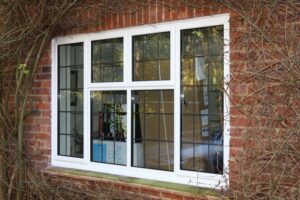A quick guide to casement windows
Casement windows have probably been the most popular style of window in the UK for decades. Even nowadays, they remain as popular as ever as the main choice for any replacement windows project.
So what are casement windows and what makes them so popular?
Casement window features
- A casement window usually opens outwards from the side hinges.
- They can be hinged at the top (awning) or at the bottom (hopper) if needed.
- If you use 2 casements side by side opening from the centre, you now have a French Window.
 In the image to the right, you see a standard top hinged casement window.
In the image to the right, you see a standard top hinged casement window.
This type of design is typically fitted to a utility room, bathroom or other space where only the top section needs to open for ventilation.
You will not be able to use this awning casement style as a means of escape in an emergency, so bear that in mind.
A more typical example that you will find around a property is an awning casement that also has side hinged casements in the same frame.
In the image on the left, you can see many variations and configurations of opening and fixed section options.
It’s not all the permutations that you can get, but it should give you a good idea of how versatile this design is at meeting the needs of many different properties.
Materials for the frame
In our opinion, by far the most popular material to use for the frames is UPVC. This material is relatively cheap compared to hardwood or aluminium and has a long life with good energy efficiency stats.
In terms of visual effect, you can find UPVC casement windows in around 14 to 20 different colours – this will depend on your supplier and availability. However, coloured UPVC costs more than plain white. You can add a wood grain texture, but that will also cost more.
